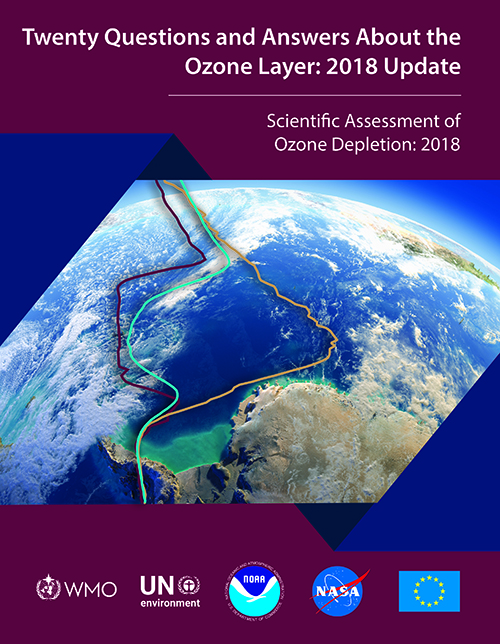2019 News & Events
Twenty Questions and Answers About the Ozone Layer: 2018 Update
4 November 2019

The third component of the Scientific Assessment of Ozone Depletion: 2018, the Twenty Questions and Answers About the Ozone Layer: 2018 Update, was released today at the Montreal Protocol Meeting of the Parties in Rome, Italy. The Montreal Protocol on Substances that Deplete the Ozone Layer was signed in 1987, then amended and adjusted in subsequent years, with the goal of protecting Earth's ozone layer from depletion by manmade ozone-depleting substances, such as chlorofluorocarbons (CFCs) and halons. Actions of the Parties to the Montreal Protocol are informed by its Scientific, Technology & Economics, and Environmental Effects Assessment Panels.
The lead author of the Twenty Questions document, Ross Salawitch of the University of Maryland, managed a team of co-authors including Michaela Hegglin (University of Reading, UK), Walter Tribbett and Laura McBride (University of Maryland), David W. Fahey (NOAA ESRL/CSD Director), and Sarah Doherty (CIRES and the University of Washington). CSD led the organization and production of the Twenty Questions document as it has for three decades. Sarah Doherty was the overall coordinator/editor and Debe Dailey-Fisher (NOAA) and Annie Reiser (NOAA) managed the asethetic design and layout of the document.
The 2018 Twenty Questions and Answers was prepared by the Scientific Assessment Panel (SAP) of the Montreal Protocol on Substances that Deplete the Ozone Layer and is the fourth update of the original edition. The motivation behind this scientific publication, popular among policymakers, is to tell the story of ozone depletion, ozone-depleting substances, and the success of the Montreal Protocol. The questions and answers format divides the narrative into topics that can be read and studied individually by the intended audience of specialists and non-specialists. The topics range from the most basic (e.g., What is ozone?) to more complex topics (e.g., the relationship between ozone depletion and climate change), and includes recent developments (e.g., the Kigali Amendment).
The Twenty Questions document includes updated information based on the findings in the Scientific Assessment of Ozone Depletion: 2018 report (588 pages), the highlights of which were presented in the Assessment Executive Summary (67 pages). The creation of this trio of documents is a two-year endeavor carried out under the auspices of the World Meteorological Organization and the United Nations Environment Programme, with support from NOAA, NASA, and the European Commission. More than 200 scientists and support staff from 32 countries contribute to its preparation and review.
The Ozone Assessment products contribute to NOAA's mission to provide decision-relevant scientific information on atmospheric issues that pertain to the public welfare. The periodic updates of the "state of understanding" regarding the ozone layer have enabled the countries of the world to avoid harmful effects of increased surface ultraviolet radiation that would have occurred in the absence of the Montreal Protocol. The Montreal Protocol has also had co-benefits for climate, because most ozone-depleting substances are also greenhouse gases. The Kigali Amendment to the Protocol, which was signed in 2016 and entered into force of 1 January 2019, significantly enhances the climate benefits of the Protocol over the coming decades by putting into place enhanced controls on the emissions of climate-warming gases used as replacements for ozone-depleting substances.